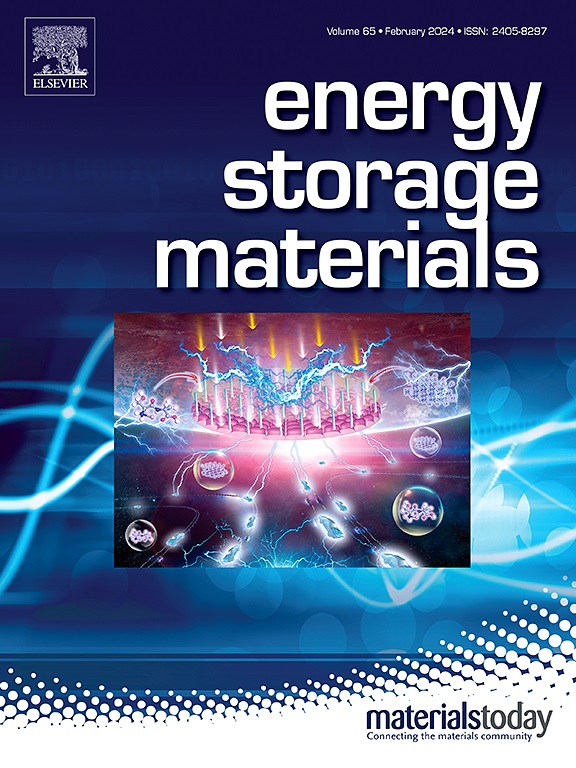Creating electrostatic shielding effects through dual-salt strategy to regulate coordination environment of Li⁺ and realize high-performance all-solid-state lithium metal batteries
IF 18.9
1区 材料科学
Q1 CHEMISTRY, PHYSICAL
引用次数: 0
Abstract
All-solid-state lithium metal batteries with polymer-ceramic solid electrolytes (PCSE) have garnered significant attention due to their high design flexibility. However, their low ionic conductivity and interfacial issues often impede commercialization. This study uses a Polyethylene Oxide-Li1.5Al0.5Ge1.5(PO4)3 electrolyte model and introduces K⁺ to create a dual-salt composite polymer solid electrolyte. By establishing an electrostatic shielding effect and adjusting the Li+ coordination environment, the electrolyte's performance is enhanced. Theoretical and experimental results indicate that K⁺ does not participate in electrochemical reactions but instead accumulates in specific regions, promoting uniform Li⁺ deposition. Additionally, competitive coordination interactions (K⁺-TFSI⁻-Li⁺) facilitate in-situ decomposition of TFSI⁻ and PF6⁻, forming a LiF–Li₃N–Li₂O rich SEI with low impedance. Results show that the symmetric cell achieves stable plating/stripping for 1000 h at a current density of 0.2 mA/cm2 without short-circuiting, and it is compatible with both LiFePO4 (LFP) and high-voltage LiNi0.8Mn0.1Co0.1O2 (NCM811) cathodes. This study constructs a dual-salt composite polymer solid electrolyte, revealing the interactions between molecules and ions within the electrolyte and laying a foundation for the further development of all-solid-state batteries.

通过双盐策略产生静电屏蔽效果,调节Li +的配位环境,实现高性能全固态锂金属电池
聚合物陶瓷固体电解质(PCSE)全固态锂金属电池因其高设计灵活性而备受关注。然而,它们的低离子电导率和界面问题往往阻碍商业化。本研究采用聚乙烯氧化物- li1.5 al0.5 ge1.5 (PO4)3电解质模型,引入K +制备双盐复合聚合物固体电解质。通过建立静电屏蔽效应和调节Li+配位环境,提高了电解质的性能。理论和实验结果表明,K +不参与电化学反应,而是在特定区域积累,促进了Li +的均匀沉积。此外,K + -TFSI -Li⁺促进TFSI⁻和PF6⁻的原位分解,形成低阻抗的富li -Li₃N-Li₂O SEI。结果表明,该对称电池在0.2 mA/cm2电流密度下可实现1000 h的稳定镀/剥离,且不发生短路,兼容LiFePO4 (LFP)和高压LiNi0.8Mn0.1Co0.1O2 (NCM811)阴极。本研究构建了双盐复合聚合物固体电解质,揭示了电解质内部分子与离子之间的相互作用,为全固态电池的进一步发展奠定了基础。
本文章由计算机程序翻译,如有差异,请以英文原文为准。
求助全文
约1分钟内获得全文
求助全文
来源期刊

Energy Storage Materials
Materials Science-General Materials Science
CiteScore
33.00
自引率
5.90%
发文量
652
审稿时长
27 days
期刊介绍:
Energy Storage Materials is a global interdisciplinary journal dedicated to sharing scientific and technological advancements in materials and devices for advanced energy storage and related energy conversion, such as in metal-O2 batteries. The journal features comprehensive research articles, including full papers and short communications, as well as authoritative feature articles and reviews by leading experts in the field.
Energy Storage Materials covers a wide range of topics, including the synthesis, fabrication, structure, properties, performance, and technological applications of energy storage materials. Additionally, the journal explores strategies, policies, and developments in the field of energy storage materials and devices for sustainable energy.
Published papers are selected based on their scientific and technological significance, their ability to provide valuable new knowledge, and their relevance to the international research community.
 求助内容:
求助内容: 应助结果提醒方式:
应助结果提醒方式:


